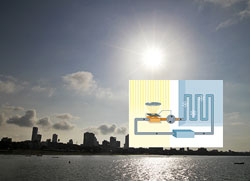Air Conditioning System That Cools with Sunlight

Air conditioning systems contribute a lot to CO2 emissions in these hot regions. About 60 percent of the electricity consumed in Indian office buildings on workdays is used for air conditioning. The latest issue of the research magazine “Pictures of the Future” reports that the developers from Siemens Corporate Technology are building an air conditioner consisting of a light collection system, which captures heat from the sun, and a photovoltaic unit that acts as the power supply. Plans call for the device to be installed on the roof of the Siemens building in Bangalore at the beginning of 2012.
This solution is based on the proven principle of the absorption refrigerator, which generally uses a salt solution. Water serves as the coolant. The collected solar energy heats up the water-salt mixture and separates the water by evaporation. The water is then condensed and pumped into a vaporizer, which cools the system. Because the interior of the vaporizer is a partial vacuum, even the low outside temperatures are high enough to evaporate the water. Heat is drawn in from the surroundings and the room is cooled. The water vapor is then once again returned to the salt solution. Because the system constitutes a cycle, the surroundings are constantly cooled. Electricity from the photovoltaic unit is required to pump the water and the salt solution through the system.
The systems used previously for this process required a large, costly photovoltaic unit, which was too big for the roofs of most office buildings. The Siemens researchers are now building a compact unit and making better use of the solar energy. The challenge they face is to simultaneously generate enough heat for the cooling process as well as electricity for the pump. One idea here is to use a special fluid that extracts enough heat from the sunlight before it reaches the photovoltaic unit. Although the amount of electricity made available wouldn’t be sufficient for conventional vapor-compression refrigeration systems, it could power the small pumps used in the absorption refrigeration process.
This technology has tremendous potential. It is estimated that India will need around 31,000 megawatts of power to cool its offices and businesses in 2015. That’s equivalent to the power produced by around 30 large coal-fired power plants.
Media Contact
More Information:
http://www.siemens.com/researchnewsAll latest news from the category: Power and Electrical Engineering
This topic covers issues related to energy generation, conversion, transportation and consumption and how the industry is addressing the challenge of energy efficiency in general.
innovations-report provides in-depth and informative reports and articles on subjects ranging from wind energy, fuel cell technology, solar energy, geothermal energy, petroleum, gas, nuclear engineering, alternative energy and energy efficiency to fusion, hydrogen and superconductor technologies.
Newest articles

Webb captures top of iconic horsehead nebula in unprecedented detail
NASA’s James Webb Space Telescope has captured the sharpest infrared images to date of a zoomed-in portion of one of the most distinctive objects in our skies, the Horsehead Nebula….

Cost-effective, high-capacity, and cyclable lithium-ion battery cathodes
Charge-recharge cycling of lithium-superrich iron oxide, a cost-effective and high-capacity cathode for new-generation lithium-ion batteries, can be greatly improved by doping with readily available mineral elements. The energy capacity and…

Novel genetic plant regeneration approach
…without the application of phytohormones. Researchers develop a novel plant regeneration approach by modulating the expression of genes that control plant cell differentiation. For ages now, plants have been the…





















